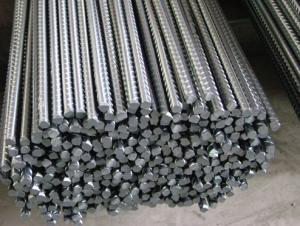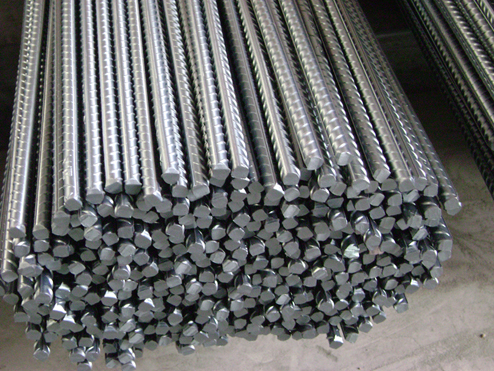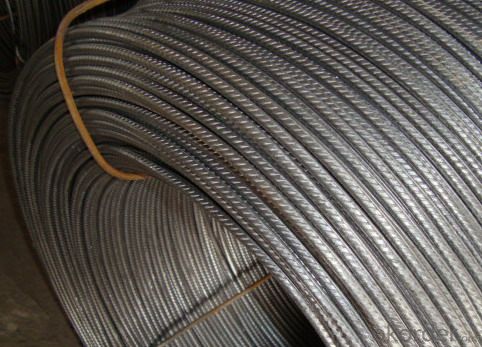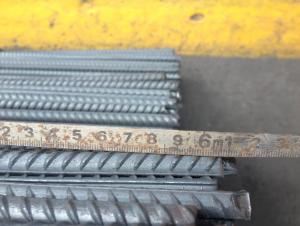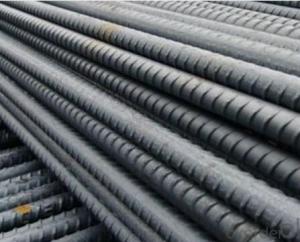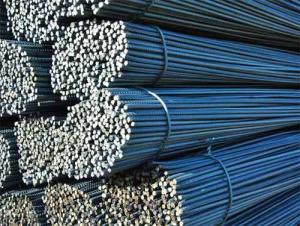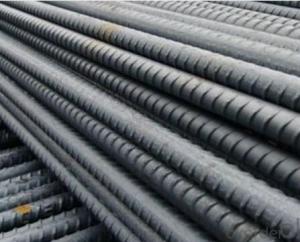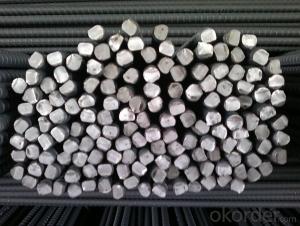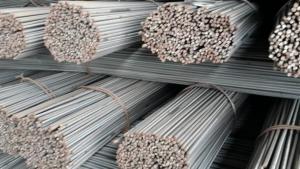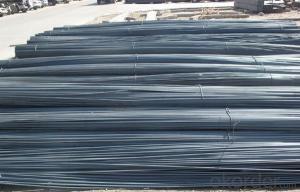Eight mm Cold Rolled Steel Rebars with High Quality
- Loading Port:
- Tianjin
- Payment Terms:
- TT or LC
- Min Order Qty:
- 50 m.t.
- Supply Capability:
- 15000 m.t./month
OKorder Service Pledge
OKorder Financial Service
You Might Also Like
1. Specifications of Eight mm Cold Rolled Steel Rebars with High Quality:
Name | Cold Rolled Steel Rebar | |
Diameter | 6mm,8mm,10mm,12mm,14mm,16mm,18mm,20mm, 22mm,25mm,28mm,32mm,36mm,40mm,50mm | |
Length | 6M, 9M,12M or as required | |
Price | Keep lower operating costs so as to offer competitive price for our clients | |
Label | to be specified by customer, generally, each bundle has 1-2 labels | |
Application | Building, construction | |
Invoicing | Actual or Theoretical Weight Basis as buyer’s request. | |
2. Theoretical weight and section area of each diameter of Eight mm Cold Rolled Steel Rebars with High Quality as below for your information:
Diameter(mm) | Section area (mm²) | Mass(kg/m) | Weight of 12m (kg) | Pcs/ton |
8 | 50.27 | 0.395 | 4.74 | 210.97 |
3. Packaging & Delivery of Eight mm Cold Rolled Steel Rebars with High Quality:
Packaging Detail: products are packed in bundle and then shipped by container or bulk vessel, deformed bar is usually naked strapping delivery, when storing, please pay attention to moisture proof. The performance of rust will produce adverse effect.
Each bundle weight: 2-3MT, or as required
Payment terms: TT payment in advance or Irrevocable LC at sight.
Trade terms :FOB, CFR, CIF
Delivery Detail: within 45 days after received advanced payment or LC.
4. FAQ:
Q1: Why buy Materials & Equipment from OKorder.com?
A1: All products offered byOKorder.com are carefully selected from China's most reliable manufacturing enterprises. Through its ISO certifications, OKorder.com adheres to the highest standards and a commitment to supply chain safety and customer satisfaction.
Q2: How do we guarantee the quality of our products?
A2: We have established an advanced quality management system which conducts strict quality tests at every step, from raw materials to the final product. At the same time, we provide extensive follow-up service assurances as required.
Q3: How soon can we receive the product after purchase?
A3: Within three days of placing an order, we will arrange production. The shipping date is dependent upon the quatity, how many sizes you want and the plan of production, but is typically 1 month to 2 month days from the beginning of production.
5. Images of Eight mm Cold Rolled Steel Rebars with High Quality:
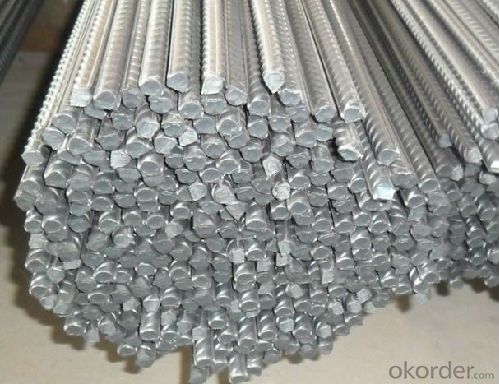
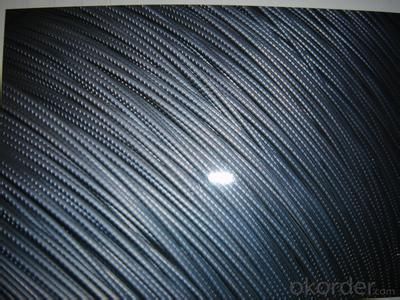
- Q: How do steel rebars affect the fire resistance of concrete structures?
- Steel rebars can significantly enhance the fire resistance of concrete structures. The presence of steel rebars within concrete provides reinforcement and prevents the structure from collapsing under high temperatures. The steel rebars act as a heat sink, absorbing and dissipating heat away from the concrete, thereby delaying the onset of structural failure. This improved fire resistance allows concrete structures with steel rebars to maintain their integrity for a longer duration during a fire event, providing valuable time for evacuation and firefighting efforts.
- Q: How do steel rebars affect the bond strength between concrete and reinforcement?
- Steel rebars have a significant positive impact on the bond strength between concrete and reinforcement. When embedded in concrete, rebars enhance the structural integrity by creating a mechanical bond. The rough texture of rebars provides a larger surface area for the concrete to adhere to, improving the bond strength. This bond is crucial in transferring forces between the two materials, ensuring the reinforced concrete can withstand loads and maintain its stability.
- Q: What is the role of steel rebars in bridge deck construction?
- Steel rebars play a crucial role in bridge deck construction. They are used to reinforce the concrete used in the construction of the bridge deck. The main function of rebars is to provide tensile strength to the concrete, as concrete is strong in compression but weak in tension. Bridge decks are subjected to various loads, including the weight of the vehicles, live loads, and environmental factors such as temperature changes and vibrations. These loads can cause the bridge deck to bend, crack, or even collapse if it lacks sufficient tensile strength. By incorporating steel rebars into the bridge deck, the tensile strength of the concrete is significantly enhanced. The rebars are strategically placed throughout the concrete structure to distribute the loads and resist tension, thereby preventing cracks and ensuring the overall structural integrity of the bridge. In addition to reinforcing the concrete, steel rebars also help to control cracks that may occur due to shrinkage or thermal expansion. When the concrete shrinks or expands, it can lead to the formation of cracks, which can compromise the durability and stability of the bridge. However, the inclusion of rebars helps to control and limit the size and extent of these cracks, ensuring the long-term performance of the bridge. Furthermore, steel rebars also aid in the transfer of loads between different components of the bridge, such as the bridge deck and the supporting piers or abutments. They help to create a continuous load path, ensuring that the loads are efficiently transmitted and distributed throughout the bridge structure. In summary, steel rebars are essential in bridge deck construction due to their ability to provide the necessary tensile strength to the concrete. They enhance the structural integrity of the bridge, control cracks, and facilitate the transfer of loads, ultimately ensuring the safety and longevity of the bridge.
- Q: How do steel rebars improve the durability of concrete structures?
- Steel rebars improve the durability of concrete structures by providing added strength and reinforcement. They enhance the load-bearing capacity of the concrete, prevent cracking and deformation, and increase resistance to tension and bending forces. This reinforcement helps to minimize structural damage caused by factors like heavy loads, seismic activity, temperature fluctuations, and corrosion, ultimately increasing the lifespan and overall durability of the concrete structure.
- Q: What is the role of steel rebars in pile foundation construction?
- Steel rebars play a crucial role in pile foundation construction. Pile foundations are used to transfer the load of a structure to deeper layers of soil or rock, ensuring stability and preventing settlement. In this process, steel rebars are used to reinforce the concrete piles, enhancing their strength and durability. The main function of steel rebars in pile foundation construction is to provide tensile strength to the concrete. While concrete is strong in compression, it is weak in tension. By placing steel rebars within the concrete, the resulting combination creates a reinforced structure that can withstand both compression and tension forces. Steel rebars also help to prevent cracking and provide structural integrity to the piles. As the piles are subjected to various loads, including vertical and lateral forces, the rebars help distribute these loads evenly and prevent the concrete from cracking or failing under stress. This ensures the stability and longevity of the pile foundation. Furthermore, steel rebars help to improve the overall performance of the piles. They increase the overall load-carrying capacity of the foundation, allowing it to support heavier structures or loads. The rebars also enhance the resistance of the piles to various external factors such as earthquakes, wind loads, and soil movement. In summary, the role of steel rebars in pile foundation construction is to provide tensile strength, prevent cracking, and enhance the overall performance and durability of the foundation. The use of steel rebars ensures that the pile foundation can effectively transfer loads and maintain stability, making it an essential component in the construction of strong and reliable structures.
- Q: How do steel rebars affect the environmental sustainability of a structure?
- Steel rebars can have both positive and negative impacts on the environmental sustainability of a structure. On the positive side, steel rebars provide high strength and durability to the structure, allowing it to withstand the test of time and reduce the need for frequent repairs or replacements. This can result in lower resource consumption and waste generation over the lifespan of the structure. Additionally, steel rebars can be recycled at the end of their life, reducing the demand for new raw materials and minimizing carbon emissions associated with steel production. However, the production of steel rebars involves significant energy consumption and carbon emissions, contributing to climate change. The extraction and processing of iron ore, as well as the manufacturing of steel rebars, require large amounts of energy and can have negative impacts on air and water quality. Furthermore, the transportation of steel rebars to construction sites can also contribute to carbon emissions. To ensure the environmental sustainability of a structure, it is important to consider the entire life cycle of steel rebars, from raw material extraction to end-of-life recycling. Implementing sustainable practices such as using recycled steel, optimizing the design to reduce the amount of steel required, and minimizing transportation distances can help mitigate the negative environmental impacts of steel rebars and promote a more sustainable construction industry.
- Q: What are the guidelines for storing steel rebars on a construction site?
- The guidelines for storing steel rebars on a construction site typically include keeping them off the ground to prevent rust and corrosion, stacking them neatly and securely to avoid accidents, and protecting them from exposure to moisture and other harmful elements. It is also important to separate different sizes and types of rebars to ensure easy identification and accessibility when needed.
- Q: What is the lifespan of steel rebars in a concrete structure?
- The lifespan of steel rebars in a concrete structure can vary depending on various factors such as the quality of the steel, the level of exposure to environmental conditions, and the maintenance practices. However, generally speaking, steel rebars in a well-constructed and properly maintained concrete structure can last for several decades or even more than a century.
- Q: How do steel rebars affect the overall sound insulation of a building?
- The overall sound insulation of a building is not directly affected by steel rebars. Steel rebars serve to reinforce concrete structures and offer strength and stability in construction. Sound insulation is primarily determined by the materials and design of walls, floors, and ceilings, as well as the correct installation of acoustic barriers and insulation materials. Although steel rebars can transmit sound to a certain degree due to their density, their impact on sound insulation is usually insignificant when compared to other factors. To achieve sound insulation in buildings, it is necessary to utilize materials with excellent sound absorption properties, such as acoustic insulation panels, mineral wool, or soundproofing barriers.
- Q: Can steel rebars be used in structures with heavy dynamic loads?
- Yes, steel rebars can be used in structures with heavy dynamic loads. Steel rebars are commonly used in reinforced concrete structures to provide tensile strength and improve the overall structural integrity. They are specifically designed to withstand heavy loads, including dynamic loads such as those caused by vibrations, earthquakes, or moving vehicles. The high tensile strength of steel rebars allows them to absorb and distribute the dynamic loads effectively, preventing structural failure or collapse. Additionally, steel rebars have excellent fatigue resistance, which means they can withstand repeated loading and unloading cycles without losing their strength or integrity. To ensure proper performance under heavy dynamic loads, engineers consider various factors such as the size, shape, and spacing of rebars, as well as the concrete quality and the design of the structure itself. By carefully designing and reinforcing the structure with steel rebars, it is possible to create a safe and durable building that can withstand heavy dynamic loads.
Send your message to us
Eight mm Cold Rolled Steel Rebars with High Quality
- Loading Port:
- Tianjin
- Payment Terms:
- TT or LC
- Min Order Qty:
- 50 m.t.
- Supply Capability:
- 15000 m.t./month
OKorder Service Pledge
OKorder Financial Service
Similar products
Hot products
Hot Searches
Related keywords
